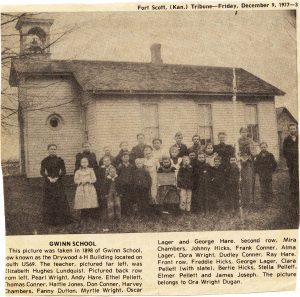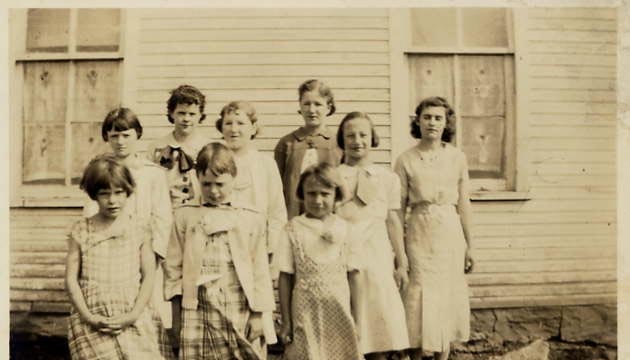
When you are clearing out a house, you might be inclined to just dump old papers that don’t look like they have been touched for decades. However, before you just dump that box, bag, or drawer of old receipts, newspaper clippings and other papers, take a look at them. You might be surprised what general history, local history, and family history they hold. You might even find yourself fascinated by them.
Preserving Everything
My parents preserved many things, but today’s article takes a look at the “paper” they preserved. Mom was the Newspaper Clipping Queen. She cut out articles about the family, neighbors, the neighborhood, historic events, and more. Meanwhile, neither of them got rid of receipts for key items, memorial cards from funerals, invitations, or announcements. And, they didn’t touch any papers that they inherited. Thus, I have been going through “paper” for years and for every stack I go through, I only inch closer to being done.
This article touches on a few examples of the things they kept, focusing on local and family history.
 Births, Marriages, Deaths, and Interesting Stories
Births, Marriages, Deaths, and Interesting Stories
My parents had hundreds, if not thousands, of newspaper clippings. If you are related to people in Fort Scott, Drywood Township, or Pawnee Township in Bourbon County, Kansas, Mom just may have cut out an article about your family. The challenge with these clippings, in many cases, is to figure out if the people are related to us or not. This is particularly true of people in mom’s family and the neighborhood where she grew up (Drywood Township), as it seems like most everybody is related in some way. Even after doing genealogy for nearly 30 years, I still haven’t untangled all of the people that lived in that area.
Newspaper articles are wonderful. I enjoy them and they have provided facts or clues when I was researching someone. In some cases, I couldn’t have figured out who someone was without them. But, what I like most about them is that they bring my ancestors and the people they knew to life. For instance, the story in the article from 1946 adds so much to the story of the Pellett family. Like all other families, they were so much more than vital statistics.

Note: Rufus Pellett was not a direct ancestor. However, like all the Pelletts in Bourbon County, he was a relative.
Church Records

Church records among the many papers that were in my parents’ home include membership records, church directories, attendance records, and church bulletins.
My mom’s membership card at what is now the United Methodist Church in Fort Scott is shown. It appears that she was a member at the church in 1955, if I am reading the date correctly. That leads to another fun challenge with all the records – reading the handwriting.
HINT: If you have a paper record and cannot read the handwriting, take a photo and enlarge it on your phone/computing device. Often enlarging it makes it more readable.
Licenses
 Hunting & Fishing Licenses
Hunting & Fishing Licenses
Grandpa Joseph Andrew McCracken’s fishing license tells us that at age 47, he was 5’9” tall, weighed 180 pounds, had blue eyes, and brown hair. If we didn’t know his date of birth, this license would tell us that he was born about 1894. His hunting and driver’s licenses tell us similar information, although for some reason his weight, hair color, and height all seem to be variable from license to license. Still, we get the general idea.
Driver’s License
Grandma Nellie (Peelle) McCracken got a driver’s license in 1931. It is unclear how much it really got used as she much preferred to ride a horse or drive a team of horses than to drive a car. In any case, it is similar to grandpa’s fishing license in that it tells us similar information about her. She was 5’4”, had blue eyes, and light colored hair. A woman, however, never admits her age or weight. She did on the license, but I won’t disclose it here. Her driver’s license also shows her address and gives her signature.
HINT: Licenses and military records are good places to find descriptions of ancestors.
Hardware Receipts
I.E. Morrison
This receipt is especially interesting because it lists both Hiattville and Pawnee as business locations. There never were many that did business in both towns and receipts from them are few and far between. In addition, Ester (McCracken) Fisher, Lydia Peelle, and possibly other family members worked at Morrison’s store.
Williams Hardware
This Williams Hardware receipt was written for Baldwin Barker. It was likely in my parent’s possession because my grandfather was the administrator of Baldwin’s estate. Also included in my parents papers is a newspaper showing a long list of items to be sold at a sale after Baldwin’s death in 1928.
Of note to the family, Baldwin, his wife, and children lived in the house that I grew up in.

 Hills Brother Lumber
Hills Brother Lumber
The interesting thing about this receipt for lumber is that the lumber company was on the plaza in Fort Scott. That area was so very interesting. Although I don’t remember this particular business, I do remember going into businesses on the plaza when I was young.
I do not know why the name is McPheron. That is a total mystery to me. There were people with that name that lived in Bourbon County at one time. I don’t know if this purchase was for someone in that family or if an error was made in the name.”
Banks
 Hiattville State Bank
Hiattville State Bank
The Hiattville State Bank was formed in 1907 with $10,000 in capital. One of the original stockholders was John Hartnett, who was a first cousin to my great grandmother, Matilda (Jury) Peelle. John was also the first child born in Hiattville.
The document from Hiattville State Bank is intriguing because it states that the bank is crediting the account; however, it has no name or account number on the document.
Farlington State Bank
This bank document was from less than three years after the bank was formed on October 25, 1915 by members of the Martin family. The bank initially had $10,000 in capital, a new brick building, a burglar-proof safe, and a large vault. However, the bank closed July 24, 1924, less than ten years after it was formed. Elmer Poole, cashier at the bank, was sent to jail for accepting deposits when he knew the bank was insolvent. However, he was cleared of embezzling funds.
The document is particularly interesting from a family history perspective because it is signed by Grandpa Joseph Andrew McCracken, his father Andrew Johnson McCracken, and his mother-in-law Matilda Peelle, which is a rare combination of signatures. Also, the interest rate was 8%, which was very common in that era.
 Cars
Cars
The automobile registration receipts (and there are quite a number of them) tell the story of the vehicles that the family owned over the years.
This example shows that they owned a 1935 Studebaker sedan in 1952. One thing that was generally consistent is that they tended to own older cars. When Dad was 21, he was driving a 1928 Ford Coupe. It was as old as he was.
In 1943, Grandpa Jsoseph Andrew McCracken owned a 1933 Plymouth Sedan. This car had bad tires and Grandpa went to buy a new set. However, before the sale was final the United States entered World War II and the sale of new tires was restricted. So, the family didn’t get a set of new tires until after the war.
Tax Statements
The tax statement shows the real estate property Joe McCracken owned in 1951, including the acreage and tax. What surprised me, but shouldn’t have, was that it had the school district listed on the form. From this tax form, it appears that Rocky Vale ceased to exist, at least ceased to exist as a separate school district, prior to 1951.
So Much More
These records don’t begin to scratch the surface of the many documents that my parents stored for decades. Other types of paper documents they kept include photographs, letters, greeting cards (so many of them), various mortgage and insurance documents, certificates, school records, and legal records.
Among the many receipts are the receipt for the birth of one of Dad’s siblings, the receipt for my mother’s wedding rings, and even for the 1954 Ford tractor.
One of the most interesting is a Jury summons, as it is embossed with a seal. It is far fancier than the postcards I have gotten.
Last, but not least, an old mimeographed copy of a list of heirs for the probate case of Minnie Alameda (McCracken) Munroe, sister to Andrew Johnson McCracken, may have been the most helpful document of all. It contained names that I did not know and led me to find that Lemuel Lawrence McCracken, my great-great grandfather, had been married before he married Louisiana Matteer, my great-great grandmother. I also discovered through that document that Louisiana had also been married prior to their marriage. Thus, one document from decades ago led me to two branches of family.
So, if you wonder how I know so much about family and local history, it is in part due to my parents and the fact that they never threw out “important” papers!
Sources: The 50 year ago clipping is from the Fort Scott Tribune. The one for Kay’s wedding is likely from the same newspaper.
 Births, Marriages, Deaths, and Interesting Stories
Births, Marriages, Deaths, and Interesting Stories Hunting & Fishing Licenses
Hunting & Fishing Licenses
 Hills Brother Lumber
Hills Brother Lumber Hiattville State Bank
Hiattville State Bank
 Cars
Cars


















 Lone Elm School
Lone Elm School








 Later, O’Ella (McCracken) Ross, Dee (McCracken) Burnam, and Don McCracken all taught at Rocky Vale. O’Ella taught at the school 1933-1935. Dee only taught there one year in the 1940s.
Later, O’Ella (McCracken) Ross, Dee (McCracken) Burnam, and Don McCracken all taught at Rocky Vale. O’Ella taught at the school 1933-1935. Dee only taught there one year in the 1940s.







